How to Give User Write Access to a File Inside a Read Only Folder
Unremarkably, y'all don't have to worry near permissions in Windows because that's already taken care of by the operating arrangement. Each user has their own profile and their own set of permissions, which prevents unauthorized access to files and folders.
There are times, however, when y'all might want to manually configure the permissions on a set of files or folders in order to prevent other users from accessing the data. This mail service is assuming the other "people" also have access to the same estimator yous are using.
If not, yous may besides just encrypt your hard bulldoze and that's it. Nonetheless, when others can access the estimator, like family or friends, then permissions can come in handy.
Of course, there are other alternatives like hiding files and folders using file attributes or by using the command prompt to hide data. You can even hide an entire drive in Windows if y'all like.
If you are looking to prepare permissions in order to share files with others, cheque out my mail on creating a subconscious network share or how to share files across computers, tablets and phones.

Data Security
The simply other occasion where you lot will need to mess effectually with folder or file permissions is when y'all get a Permission Denied mistake when trying to access information. This means you can take buying of files that don't vest to your current user business relationship and still access them.
This is of import because it ways that setting permissions on a file or folder does non guarantee the security of that file or folder. In Windows, an administrator on any Windows PC tin override the permissions on a gear up of files and folders past taking buying of them. One time you have ownership, you lot can set your own permissions.
So what does this mean in English? Basically, if you have data you don't want others to come across, then you lot should either not shop it on that computer at all or you should use an encryption tool like TrueCrypt.
For those tech-savvy readers, y'all'll probably exist saying "Hey look, TrueCrypt has been discontinued due to security vulnerabilities and shouldn't be used!" Well, that is correct, however, TrueCrypt has been audited by an independent arrangement and Phase I and Phase Two have been completed.
The only version yous should download is TrueCrypt vii.1a, the one that has been uploaded to a verified mirror on GitHub. If you are non comfortable at all using TrueCrypt, the merely other suggestion I have is VeraCrypt, which was the successor to TrueCrypt, but stock-still many of the flaws.
File and Folder Permissions
At present that we got all of that out of the way, let's talk most permissions in Windows. Every file and every folder in Windows has its ain set up of permissions. Permissions can exist broken down into Access Command Lists with users and their corresponding rights. Hither is an case with the user list at the peak and the rights at the bottom:
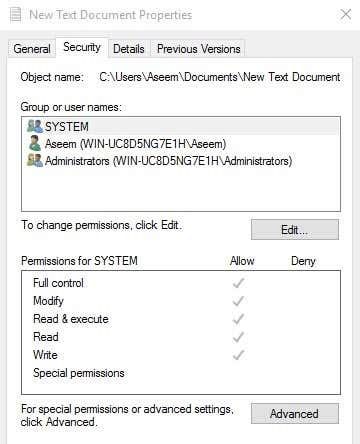
Permissions are also either inherited or not. Normally in Windows, every file or folder gets their permissions from the parent folder. This hierarchy keeps going all the mode upwards to the root of the hard bulldoze. The simplest permissions accept at to the lowest degree 3 users: SYSTEM, currently logged in user account and the Administrators grouping.
These permissions usually come from the C:\Users\Username binder on your hard bulldoze. You tin can admission these permissions by correct-clicking on a file or folder, choosing Properties and then clicking on the Security tab. To edit permissions for a particular user, click on that user and so click the Edit button.
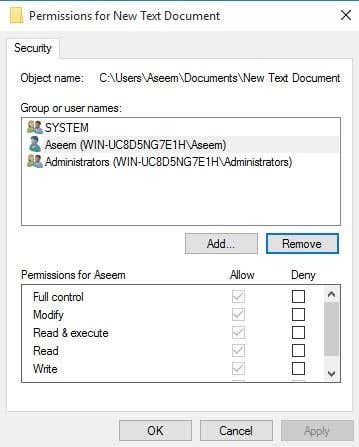
Note that if the permissions are greyed out, like in the example above, the permissions are existence inherited from the containing folder. I'll talk nearly how you can remove inherited permissions further beneath, but offset allow'due south empathize the different types of permissions.
Permission Types
There are basically six types of permissions in Windows: Full Control, Modify, Read & Execute, Listing Folder Contents, Read, and Write. List Folder Contents is the only permission that is sectional to folders. There are more than advanced attributes, simply you'll never need to worry about those.
Then what do each of these permissions mean? Well, here is a dainty nautical chart from Microsoft'due south website that breaks on what each permissions ways for files and for folders:
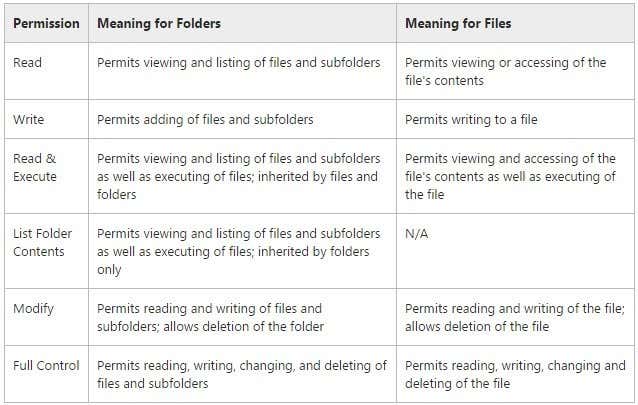
Now that y'all understand what each permission controls, let's take a look at modifying some permissions and checking out the results.
Editing Permissions
Before yous can edit whatsoever permissions, you have to accept ownership of the file or folder. If the owner is another user account or a system account like Local Organization or TrustedInstaller, you won't be able to edit the permissions.
Read my previous post on how to accept ownership of files and folders in Windows if yous are currently not the owner. Now that you are the possessor, let's get a few more than things out of the way:
-
If you lot set Full Control permissions on a folder for a user, the user will exist able to delete any file or subfolder regardless of what permissions are set for those files or subfolders.
-
By default permissions are inherited, and then if yous desire custom permissions for a file or folder, you have to first disable inheritance.
-
Deny permissions override Allow permissions, and so use them sparingly and preferably just on specific users, not groups
If y'all right-click on a file or binder, choose Properties and click on the Security tab, we can now attempt to edit some permissions. Become ahead and click the Edit push button to become started.

At this bespeak, there are a couple of things y'all tin can do. Firstly, you'll find that the Permit column is probably greyed out and tin't be edited. This is because of the inheritance I was talking about earlier.
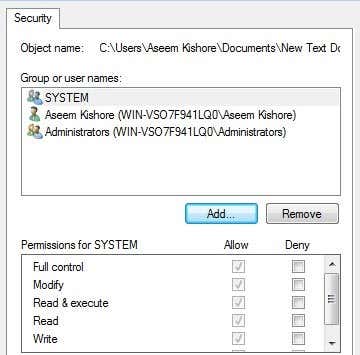
However, you can check items on the Deny column. So if you but want to block access to a folder for a specific user or group, click the Add together button offset and one time added, you lot tin check the Deny button next to Total Control.
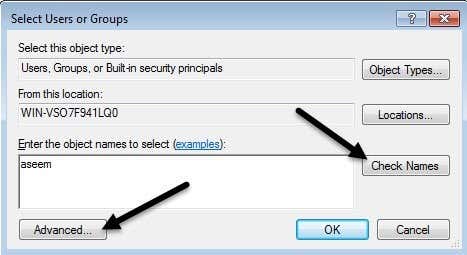
When you click the Add button, yous have to blazon in the user proper name or group name into the box and and so click on Check Names to make sure it's right. If you don't remember the user or group proper name, click on the Advanced button and then just click Find Now. It will show you all the users and groups.
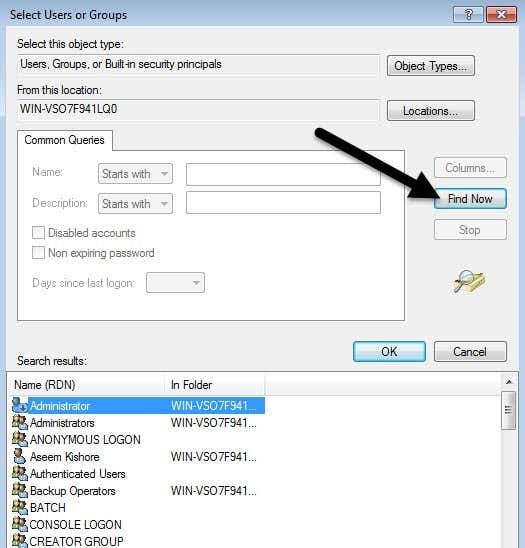
Click OK and the user or group will be added to the access control list. Now y'all tin check the Let column or Deny column. Equally mentioned, attempt to utilise Deny just for users instead of groups.
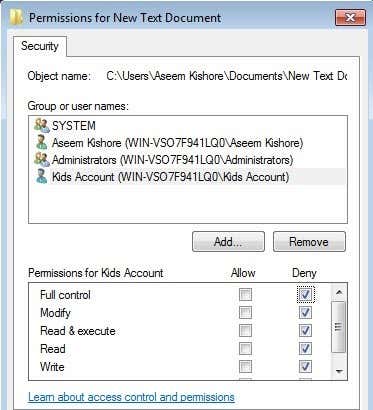
Now what happens if we try to remove a user or grouping from the list. Well, you tin can easily remove the user y'all just added, but if you attempt to remove any of the items that were already in that location, you'll get an error bulletin.
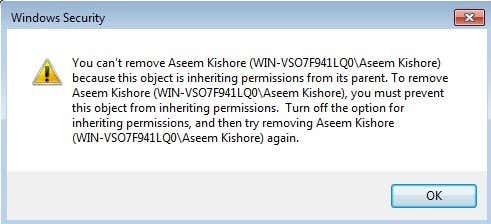
In lodge to disable inheritance, you lot have to go dorsum to the main Security tab for the file or folder and click on the Avant-garde button at the bottom.

On Windows 7, you'll 1 extra tab for Possessor. In Windows 10, they just moved that to the peak and you take to click Modify. Anyway, in Windows 7, click on Change Permissions at the bottom of the beginning tab.
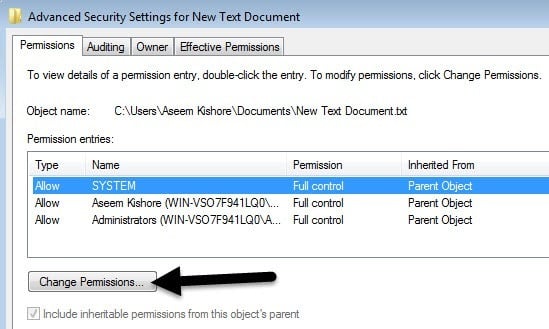
On the Advanced Security Settings dialog, uncheck the Include inheritable permissions from this object's parent box.
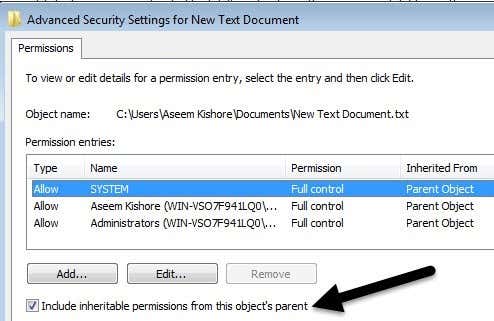
When you do that, another dialog box will popup and it will ask you lot whether you lot desire to convert the inherited permissions to explicit permissions or whether you simply want to remove all the inherited permissions.
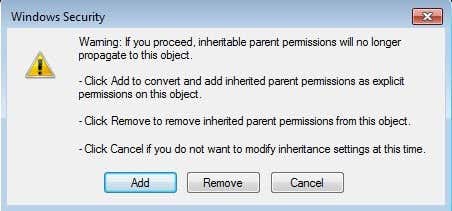
Unless y'all actually know exactly what permissions you lot want, I suggest choosing Add together (explicit permissions) and so just removing any yous don't want later on. Basically, clicking on Add will continue all the aforementioned permissions, just now they won't be greyed out and you can click Remove to delete any user or group. Clicking Remove, will start you off with a clean slate.
In Windows x, information technology looks slightly different. After clicking on the Advanced button, you have to click on Disable Inheritance.
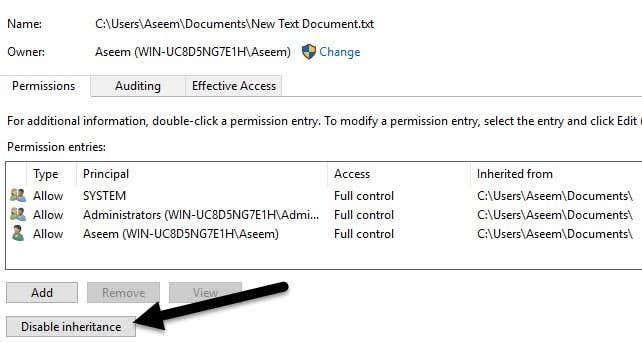
When you click on that button, you'll get the same options as in Windows 7, but just in a different form. The Convert pick is the same equally Add together and the 2nd option is the same every bit Remove.
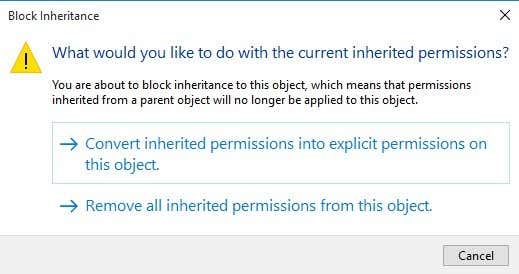
The only matter y'all have to sympathize now is the Effective Permissions or Constructive Access tab. So what is constructive permissions? Well, let's encounter the example in a higher place. I have a text file and my account, Aseem, has Full Control. Now what if I add another particular to the listing and then that the group Users is denied Full Command.
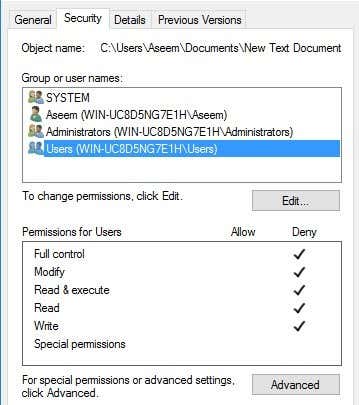
The only problem hither is that the Aseem business relationship is also part of the Users group. So I have Total Control in one permission and Deny in another, which i wins? Well, every bit I mentioned in a higher place, Deny always overrides Allow, so Deny will win, but we can also confirm this manually.
Click on Avant-garde and go to the Effective Permissions or Effective Admission tab. In Windows seven, click the Select button and type in the user or group proper name. In Windows x, click the Select a user link.
In Windows 7, one time you select the the user, information technology will instantly testify the permissions in the list box below. As y'all can see, all of the permissions are unchecked, which makes sense.
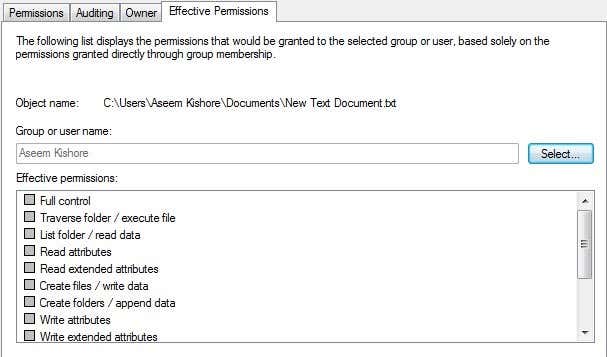
In Windows 10, you have to click the View effective access button after selecting the user. You'll also become a dainty reddish X for no admission and a dark-green check marker for allowed access, which is a bit easier to read.
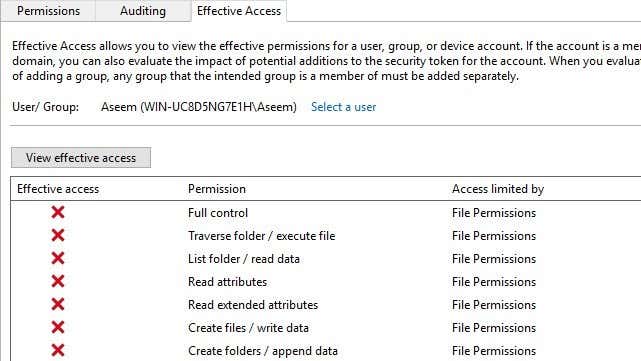
So at present you pretty much know all there is to know virtually Windows file and folder permissions. It does take some playing around yourself in order to get the hang of it all.
The chief points to understand are that yous need to be the owner in guild to edit permissions and that any administrator tin have ownership of files and folders regardless of the permissions on those objects. If you have whatsoever questions, experience free to post a comment. Enjoy!
Do not share my Personal Information.
Source: https://www.online-tech-tips.com/computer-tips/set-file-folder-permissions-windows/
Post a Comment for "How to Give User Write Access to a File Inside a Read Only Folder"